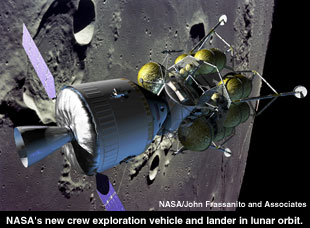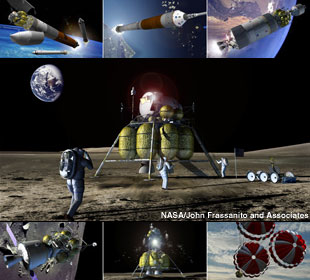|
|

|
NASA reveals plan for next moon landing

September 19, 2005 -- Before 2020, NASA astronauts will again explore the surface of the moon, according to a plan set forth by NASA Administrator Mike Griffin today.
Speaking before members of the press and employees at NASA Headquarters, Griffin shared the results of NASA's exploration architecture study, described as the "blueprint for the next generation of spacecraft to take humans back to the moon and on to Mars and other destinations."
The study makes specific design recommendations for a vehicle to carry crews into space, a family of boosters to take crews to the moon and beyond, and a "lunar mission architecture" for landing on the moon. It also outlines the technologies the space agency should pursue in the near term.
The study will assist NASA in achieving the President's Vision for Space Exploration, which calls for the agency to complete the International Space Station, return to the Moon, and continue exploration of Mars and beyond.
The next generation crew vehicle will use an improved, blunt-body crew capsule, and will accommodate up to six people.
"This spacecraft and its systems will build upon the foundation of the proven designs and technologies used in the Apollo and Space Shuttle programs, while having far greater capability," Griffin said. "It will be able to carry larger and heavier cargos into space and allow more people to stay on the Moon for longer periods of time."
The crew vehicle will be shaped like an Apollo Command Module, but it will be three times as large. It will have solar panels to provide power, and both the capsule and the lunar lander will use liquid methane for their engines.
Designed to be reused up to 10 times, after the vehicle parachutes to dry land on Earth (with a splashdown as a backup option), NASA plans to recover it and replace its heat shield to launch it again.
The new spacecraft - referred to as the Crew Exploration Vehicle or CEV - can be configured either to support human explorers or fly unpiloted to carry cargo. Its design allows the flexibility to ferry crews of three astronauts, plus additional supplies, to and from the International Space Station, take four crew members to lunar orbit, and eventually maintain up to six astronauts on a mission to Mars.
Coupled with a new lunar lander, the system sends twice as many astronauts to the Moon's surface as Apollo, and they can stay longer, with the initial missions planned for upwards of a week. And while Apollo was limited to target its landings along the moon's equator, the CEV will carry enough propellant to touchdown anywhere on the surface.

Crews and cargo will be carried into orbit by a shuttle- derived launch system, consisting of a solid rocket booster and an upper stage powered by a shuttle main engine that can lift 25 metric tons. According to NASA, the CEV also will be 10 times safer than the shuttle because of its in-line design and launch-abort system.
NASA chose this configuration for its launch system due to its projected safety, cost and its availability.
Specifically, the Space Shuttle's main engines and solid rocket boosters are rated for human space flight. Much of the industrial base and hardware to support this option are already in place, which NASA says will significantly lower development costs.
Lunar missions will be supported by a heavy cargo launch vehicle consisting of five shuttle main engines, and two five-segment shuttle solid rocket boosters. The resulting booster yields a lift capability of 106 metric tons to low earth orbit and 125 metric tons if it incorporates an Earth-departure stage. Although designed to carry payload, this system can also be human-rated to carry crew into orbit.
The study lays out a milestone-driven journey for NASA. Returning to the moon and sustaining a presence there will demonstrate humans can survive on another world, and will build confidence that astronauts can venture still farther into space and stay for longer periods.
The journey will start with robotic missions between 2008 and 2011 to study, map and learn about the lunar surface. These early missions will help choose landing sites and determine whether resources, such as oxygen, hydrogen and metals, are available for use in long-term exploration objectives.

In 2018, humans will return to the Moon. The mission as described by Griffin would unfold as follows:
A heavy-lift booster lifts off, carrying a lunar lander and a "departure stage" - similar to the Saturn V's third stage - needed to propel the spacecraft beyond Earth orbit. The crew launches separately, then docks their CEV with the lander and departure stage to head for the Moon.
Three days later, the crew goes into lunar orbit. The four astronauts climb into the lander, leaving the CEV to wait for them in orbit. After landing and exploring the surface for seven days, the crew departs the Moon in a portion of the lander, docks with the CEV and travels back to Earth.
The CEV's service module is jettisoned after a de-orbit burn, exposing the heat shield for reentry. The parachutes deploy, the heat shield is dropped and the capsule sets down on dry land.
With a minimum of two lunar missions planned per year, a 'pay-as-you-can' momentum will build toward permanent outposts. Crews will stay longer, while landers make one way trips to deliver cargo. Crews may eventually rotate to and from an outpost every six months.
NASA planners are already looking at the lunar south pole as a candidate for an outpost because of concentrations of hydrogen thought to be in the form of water ice, and an abundance of sunlight to provide power.
|

© 2023 collectSPACE.com All rights reserved.
Questions? E-mail contact@collectspace.com

|
|

|

|
